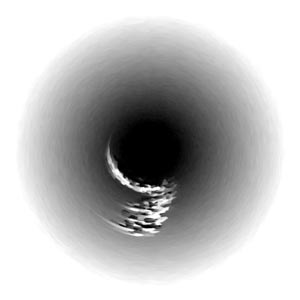In almost every religion, which the world has known, the Deity has been worshipped in the threefold aspect of a Trinity. In addition to the Christian Trinity, we know of the Osirian mythos of the ancient Egyptian, comprising the triune Osiris, Isis and Horus. There is the Scandinavian Odin, the Almighty Father: Freya, his wife, and Thor, the Son, the mediator, and again, the Hindu trinity of Brahma, Shiva and Vishnu. On the Hermetic side, Kabalism will give us another example in Abba, the Almighty Father (the Sephira Chokmah), Aima, the Great Mother (the Sephira Binah) and the mediator, the Son (the Sephira Tiphareth); these three are symbolized by the Alchemical Principles, Sulphur, Salt and Mercury and the Elements, Fire, Earth and Water respectively. Many other examples might be quoted, but this is sufficient to see why the Deity has, almost universally been represented in symbolism by the number 3 and the triangle.
On the other hand, when speaking of matter, we introduce a fourth element, air and the four elements, earth, air, fire and water include all degrees of heat and cold, dryness and moisture. In Hermetic symbolism, these four elements cover all material manifestations and we find that matter is represented by the number 4 and the square, or Greek Cross of four equal arms.
Hence, we have the symbol of 3 to represent God, or the various degrees of Spirit, and 4, Man, matter, or the manifested world. All things are included under one or other of these headings, and we find that the total of these, the number 7 is called the number of completion or perfection.
The seventh period was the perfection of the Creation by the Elohim described in the first chapter of Genesis; man must pass through seven stages of evolution on the various planes before attaining perfection, and in the present cycle, there are Seven Great Races. According to the Mosaic dispensation, every seventh year was a year for the Israelites, and every seven times seven years, they held a year of Jubilee (Levitivus 25). Further, in the Apocalypse of St. John, we read of the Book with the Seven Seals which can only be opened by the initiate who has been made perfect. In almost every branch of symbolism, the number 7 occurs again and again, and always represents completion or perfection.
Now this division of the perfect number 7 into two parts, 3 to symbolize Spirit and 4 to symbolize matter has one or two rather interesting analogies. In the Christian Church there are, properly speaking, 7 Sacraments, although some of these have fallen into disuse. There are three greater Sacraments, corresponding to the Divine Trinity:
Marriage, ordained in Paradise by God the Father; The Eucharist, instituted by God, the Son; and Baptism, the sacrament of the Holy Spirit. The latter has been divided into the outer ceremony of baptism, and the inner ceremony of confirmation.
The four lesser Sacraments were ordained by the Church on Earth, and have to some extent fallen into disuse. They are the sacraments of Ordeal, Unction, Penance and Holy Orders.
The seven ceremonial officers of this early Church are equally significant. There were three greater officers who were in Holy Orders; the Priest, the Deacon and the Sub-Deacon: this ternary is still in vogue for the celebration of Mass in the Roman Catholic Church and elsewhere. The four lesser officers were the Acolyte and Thurifer who were the messengers of the Church, the Exorcist, whose duty was to keep away the unclean spirits, and lastly, the Doorkeeper.
There are many other similar analogies, and those who are acquainted with Masonic and other systems of symbolism will find instances in which the 7 of perfection has been divided into two parts, a 3 to symbolize the Spirit of the Higher Planes, and a 4 to represent matter, the vehicle which contains Man’s Spirit during his mortal life.

